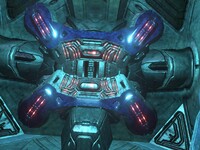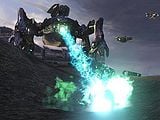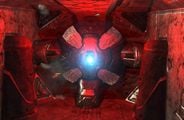Deutoros-pattern Scarab
From Halopedia, the Halo wiki
Template:Ship The Type-47 Ultra Heavy Assault Platform, more commonly known as the Scarab, is a Covenant mining vehicle adapted for use in combat.
Introduction
Scarabs are mobile fortresses deployed from high atmosphere or low to medium orbit onto the field, and the Covenant use them to the best of their abilities. The Scarab is meant to assault heavily defended structures and barriers and to give quick unstoppable support for Covenant troops on the ground. It can also deliver Covenant ground troops to their destination through heavily defended areas; this could mean death for the defending troops, such as the UNSC Marines. Unlike most Covenant ground vehicles, the Scarab does not make use of a Boosted Gravity Propulsion Drive for movement. Instead, it uses four large, powerful legs to traverse terrain most vehicles cannot, including climbing over buildings, trenches, mountains and other obstacles.
The Scarab can hold squads of Grunts and Jackals, as well as a few Brutes or Elites to prevent it from it being boarded if anything managed to get close enough. They have been used in many battles during the Human-Covenant War, such the Battle of Reach, both battles of Earth and the Battle of the Ark. If a Scarab did get boarded, and there were no surviving Covenant troops on board, the Scarab could be eliminated by destroying its vulnerable reactor.
The Scarab is also the largest known ground vehicle in the Halo Trilogy as well as the most powerful, being equipped with a powerful plasma beam cannon at the front on a "head"-like pivot, and dorsally-mounted anti-air cannons. Despite its size, weaponry, and extremely thick armor, the craft remains vulnerable to boarding actions, and if the central core is eliminated, the Scarab will detonate.[1]
Scarabs are quite notable for their intimidating, spider-like appearance, large size, and massive firepower. Their legs are surprisingly swift and accurate for their size, and were even able to find holds in narrow places, such as a canyon on Installation 05Template:Fact or the streets of Mombasa. These legs can also be used as weapons, as a monstrous pointed leg is able to crush anything that happens to get in its way, such as a truck. A Scarab's legs can be weakened or even destroyed with enough firepower.
Weaknesses
In Halo 3, one way to destroy it is to damage the joints on the legs, enough so that the Scarab must shut down temporarily, then boarding it and destroying the reactor. However, there is another method. If the rear is hit with enough firepower, the rear armor will come off, thus exposing the core to small and heavy arms fire. In the level "The Covenant" in Halo 3, this tactic is commonly used via the Hornet gunships. In the level "The Storm" there is a crane with an elevator near the Scarab. If you get on the elevator you can jump off and land on the Scarab if it is near the elevator. Then just casually walk to the power core and watch it blow. If you don't want to leave your Scorpion or Hornet, there is a weak spot on the back of the Scarab. Blow this up and the reactor is in clear sight,but this is best done when the Scarab is in temporary shutdown.
Variations
Halo Graphic Novel
In the Halo Graphic Novel, the Scarab had a very different appearance from the two game variants with a roughly cross shaped body. The across sections bore dual cannons, and neither end had a visible plasma cannon.
Its legs were a distinctly different shape (straight, with an 'L'-shaped joint to the body). It should be noted, however, that the story in which it appears, Second Sunrise Over New Mombasa, uses a very large amount of artistic license. The story is canonical (it was authorized by Bungie), but the visuals of the story clearly are not.
Halo 2
The Scarab was first seen in Halo 2 level Outskirts, and appeared as a large, four legged, silver armored behemoth with an estimated height of ninety feet. It featured a deck on top that was guarded by numerous Elites, Jackals and Grunts along with a walkway going over the entrance to its control room (you cannot see any enemies on the Scarab in Outskirts, only in Metropolis when you have to board the Scarab. There were two spine mounted plasma cannons to provide anti-air defense).
Its shell was invulnerable to damage from 90mm shells, missiles, .50 cal. rounds, and ANVIL HE missiles (the armor could be similar to the ship plating the Covenant use on their warships, and Hunter's shields). It proved vulnerable to boarding actions and destruction from inside. Bungie has joked that this Scarab looks more like a basket than an actual assault platform. As well, this Scarab did not have the plasma turret on top like the Halo 3 version. It is likely that this Scarab was more of a transport for weaker soldiers because of all Elites, Jackals, and Grunts that were giving covering fire for the pilots inside; also, it may be that this may be just a distinct Scarab only for high Prophets, for example, the Prophet of Regret. Yet another theory is that the Scarab in Halo 2 is more closely related to the original mining platform, and that the Scarab seen in Halo 3 is a more modified version. This would make sense, as Regret did not expect Earth to have such a heavy human population, and may have intended to use the Scarabs as mining equipment.
In the final level, The Great Journey, the Arbiter attempts to hijack a Scarab with the intent to break into Delta Halo's control room. Sergeant Johnson gets to the Scarab first, however. Since both he and the Arbiter were intending to keep the Halo from activating, they agree to work together. After fighting through numerous Banshees, Wraiths and other oppositions, Johnson blasts open the door to control room (which, to it's credit, takes multiple shots to destroy), and then leaves the Scarab, since it had served it's purpose. Like in Outskirts, the Scarab can't be destroyed.
Halo 3
The Scarab received major changes between Halo 2 and Halo 3, with the Scarab actually being able to be destroyed, as opposed to just killing all of the enemies inside, as seen in a Halo 2 cutscene. The Halo 2 Scarab was also piloted by a Covenant soldier, whereas the Halo 3 Scarab is controlled by a colony of Lekgolo worms in the reactor. Appearance wise, its body was changed to have a different shape, being more bulbous at the end, similar to the Wraiths of Halo: Combat Evolved. In Halo 3, it seemed to have a greater width than in Halo 2, but wasn’t as tall as previously. The Scarab in Halo 3 is also a different color than Halo 2's variant, being purple instead of blue.
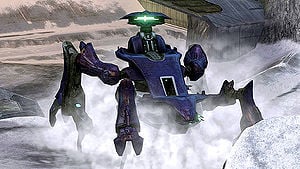
In terms of weaponry, it wielded a smaller plasma beam that seems weaker (On Legendary the player is able to withstand sustained fire for a short amount of time [approx 0.8s]), as opposed to the instant death of the Halo 2 Scarab gun). The two anti-air turrets were removed for Halo 3, having been replaced by a single, large turret at the rear (which would shoot at you if you were in a Hornet or Banshee, and you were able to shoot off the covering of it with Hornet air-to-surface missiles.)
The flaps on the plasma beam were removed, and replaced by two destructible stationary plates. As pointed out before, the Scarab now appears to have no crew controlling it, just guards, to keep boarders off, and it is controlled by Lekgolo worms.[2]Also while shooting exposed Lekgolo worms the worms can actually bleed, although the blood will not show on the ground. This has been proven in the December issue of Game Informer, in an article on the Mythic map pack. The level "Assembly" was shown to be a Scarab factory, and it was stated that tubes could be clearly seen on the level, injecting the worms into the Scarab shells.
The main gun also changed, with it appearing like a hose in Halo 3, instead of just the straight beam appearance of Halo 2. The Scarab appeared to have high impact legs due to all the jumps it makes, and it appears to be more maneuverable than in Halo 2. In Halo 3, it no longer dripped coolant/extra plasma from its belly/muzzle (gun) area and, finally, it had a darker color than in Halo 2.
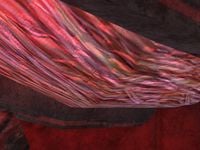
A likely conjecture is that this version of the Scarab was intended to be a weapon. Its color changed to a shade of purple, like other Covenant war-ready vehicles and it was better-defended, having superior weapons. It has been speculated that Scarabs of Halo 2 were not weapons, but rather mining tools that were deployed as emergency combat relief by Regret upon finding humans on Earth. They could have been the mining Scarabs from Fall Of Reach. This is supported by the fact that Regret was looking for the device that opened the Portal to the Ark, and he needed digging machines to excavate it. Another likely explanation for the different Scarabs encountered throughout Halo is that the Scarabs depicted in Halo 2, the Graphic Novels and Halo wars were older models of Scarab tank, while the one encountered in Halo 3 was a newer model designed to replace the older versions.
Differences aside, it still had many similarities to the old Scarab. There were three levels (or decks), and the lowest was accessible when the Scarab had been temporarily disabled. This level featured a Grunt-mounted Plasma Turret, and usually one to four Brutes, depending on the difficulty level. There was a ramp that led to the second level, where there were a varying number of enemies, depending on the level and difficulty. Usually, you could expect to find a few Brutes and Grunts. On this level, there were two more Plasma Turrets, aimed to either side of the Scarab. If you turned 180° immediately upon ascending the ramp to this level, you could go up the purple slope to the third tier. This was just an open, unprotected platform below the large turret. Past the turrets on the second level (round the corner) is the power core that must be destroyed to have taken down the Scarab.
Bungie had also stated in the September issue of EGM, that the Scarab used an unscripted game Artificial Intelligence (not to be confused with story artificial intelligence units like Cortana) to create a more dynamic battle with it, as it would roam across the battlefield of its own accord and attack targets in its path. This way it would no longer require a relatively easy boarding action every time but a tactical approach.
Halo Wars
The Scarab in Halo Wars seems to resemble more closely the Halo 3 variant, rather than the Halo 2 model. It also seems to be much smaller than previously encountered Scarabs in Halo 2 and Halo 3 (probably because of engine limitations).
A recent article in Xbox Magazine comments that an attacking Scarab "ripped (a UNSC base) a new one." It has been confirmed to be very slow and expensive to build (3000 resources in Skirmish), with no upgrade available due to their cost to be made on such a big war machine.[3]
Since Scarabs count as 20 population and cost 3000 resources, up to 2 can be spawned at a time in standard and 4 in deathmatch(each base you have gives you 10 population points in deathmatch and pop max is 99. The max population count in standard is 50 for the Covenant). Scarabs are very good against buildings, excellent against vehicles, and great against infantry. Given their extremely tough armor and powerful weaponry, destroying a Scarab is a difficult prospect. Overwhelming it with large numbers works, especially using anti-vehicle units such as the Cobra or Hunter, but a significant number of your units will be destroyed in the attempts, unless professor Anders' Cryo Bomb is used to immobilize it first. More powerful upgrades for the UNSC MAC can destroy it extremely quickly, as can several Vulture gunships using their missile barrages. For the Covenant, leader units' special abilities can deal significant damage to the Scarab, such as the Prophet of Regret's Cleansing Beam.
It can also climb over most obstacles, provided they are not craters, on fire or other miscellaneous reasons.Also even though it resembles the Halo 3 version could piloted by covenant like the Halo 2 version. It could also be the passengers are responding to the order on a Lekgolo piloted scarab.
Like Vultures, Scarabs cannot be jacked by Spartan units, the only exception is on the Halo Wars mission 13 where it is possible to hijack an empty Scarab being attacked by the Flood and grants the player the achievement Beaming with Pride for destroying 25 enemy units with it.
Super Scarab
There is a large Scarab in the 7th Halo Wars campaign mission, but it isn't complete. It is somewhat larger than a standard Scarab and appears to have more armor than a Scarab. Its weakness is that there is a beam of light that it projects that shows where it's attention is currently focused. To slow down the speed of its searchlight, you must destroy 7 power nodes, each destroyed power node slowing it down more than the last.
But if destroying power nodes seem like a bit too much work for you, Ensemble Studios was kind enough to reward your hasty maneuvers by awarding you with the achievement Micro Manager.
Destructible Parts
Halo 2
The Halo 2 Scarab was almost indestructible and immune to damage in-game. Its movement was entirely scripted, and did little else than appear as giant piece of BSP geometry. It was only destroyed in a cutscene. It should also be noted that the Scarab in the level The Great Journey seemed to be damaged under the main gun; as it fired, green plasma leaked out onto the ground, but this could be because of the firing of the gun left residue.
The forward Plasma Turret could be destroyed with just a few melee attacks, as could the rear Plasma Turret. The flaps on the main gun could be destroyed only by using a Scorpion Tank. Also, the underside grate could be destroyed.
Halo 3
There are far more destructible parts on the Halo 3 Scarab than the Halo 2 Scarab. All four of the Scarab's knees were destructible to the point that the Scarab temporarily buckled under the weight of the platform, though given time they appear to repair themselves. The armor on these legs could also be blown off. The flaps covering the Scarab's main gun could be destroyed. This did not, however, disable the weapon. The crest on and around the turret could be completely blown off, slowing the rate of fire and the size of the plasma bolts. This had been reported to temporarily disable the turret. Two side door panels near the bottom rear could be torn off to allow a singular entry.
The barrier protecting the Core could be ripped away from the back of the Scarab by shooting the red glowing circle at the top of the barrier. Doing so would result in the Core being completely exposed, making it easier to destroy. All three Plasma Cannons can be destroyed, as can the Core. If the Core is destroyed, all parts of the Scarab will be destroyed at once, except for the crest of the Scarab Gun.
Weaponry
Primary
- (1) Front-Mounted Cannon
- Ammo: Super-Heated Plasma, presumably unguided. They have unlimited ammo.
- Rate of Fire: 4 second stream; 30 to 40 per second
- Movement of cannon: Through careful examination, one can see that the inside gun part seems to move forward from a cradle as the flaps open up.
- Notes: The projectile emitted from the Scarab's main gun emits a neon-green/bluish glow, indicating extremely high temperature. As the gun fires, white, hot liquid pours from the barrel onto the ground. The gun's force is enough to destroy any vehicle smaller than the Scarab in a matter of seconds. Also, on easy or normal difficulty, if you are in a small vehicle (Mongoose, Warthog, Ghost, Chopper) the sheer force of the plasma stream hitting the ground will flip your vehicle if you are close enough. If this happens close to the Scarab it may step on (and destroy) your vehicle.
- Approx. Range: The effective range on a Scarab's main cannon is not exceptionally good, about 0.4 miles as seen during the Citadel and Cartographer battles, where its attack can easily be evaded if at a distance.
Secondary
- Mounted Anti-Aircraft Turrets (Two in Halo 2, One in Halo 3)
- Ammo: Super-Heated Plasma, (similar to Shielded Plasma Cannon) They have unlimited ammo.
- Rate of Fire: 400-600 rounds/minute
- Notes: Presumed computer controlled, but a close look indicates that it may be manually controlled. It does wildly spin around when the core is destroyed as if the automatic controls crashed. Could be shot off with little firepower. NOTE: In Halo 3 the Anti Aircraft cannon couldn’t be shot off and was invincible. The Anti Aircraft gun(s) were unsurprisingly extremely effective against aircraft.
- Approx. Range: These weapons have a much greater range than the primary cannon on the Scarab. They are extremely effective against airborne vehicles, but can also be used against ground-based vehicles, such as Warthogs or Scorpions. They are effective up to approximately 1.5 miles, which is a rough but evidence-based conclusion drawn from ships and vehicles with similar weaponry.
Strategies
- Main article: Scarab Fighting Strategies
Character Compatibility
- Elites (Halo 2 only)
- Sergeant Avery Johnson (Halo 2 only)
- Brutes (Halo 3 only)
- Lekgolo (confirmed pilots and part of the core system of Scarabs in Halo 3)
- Grunts - passengers, use as platform for plasma cannon
- Jackals - passengers
- Spartans (Halo Wars Campaign only)
Trivia
Miscellaneous
- The Scarab is one of the only Covenant vehicles that is not named after supernatural beings (like a Ghost, Banshee, Wraith, or Vampire), with the exception of Brute-made vehicles, although a Scarab was a mythological Egyptian giant beetle that pushed the Sun across the sky. This may be because it is in fact not a war machine but a piece of re-purposed mining equipment. The Locust, a smaller but otherwise similar machine, also shares its name with an insect instead.
- The Scarab Gun is a weapon that players can pick up in Halo 2; it looks like a plasma rifle and can be found on the levels Outskirts and Metropolis. It fires the same plasma stream as the Scarab's main gun, never overheats, and can fire continuous rapid fire. The Scarab Gun earns you an achievement on Halo 2 Vista.
- At close range, the explosion of a Scarab has enough power to kill a Spartan (or anyone else who is close enough). It can be observed that every level on which there is a Scarab also has many vehicles nearby to make a good escape.
- A Scarab is an Egyptian beetle that was worshiped as a manifestation of Khepri, an Egyptian god who drove the sun across the sky.
- It is speculated that Scarabs are the Sharquoi mentioned in Conversations from the Universe.
- It is also notable that when a Scarab's leg is disabled, it emits a loud beep, much like that of a reversing truck (except at a lower pitch). This effect is perhaps a nod to the same death sequence (and sound) of the Juggernaut flying tanks in a previous Bungie game Marathon.
- The Scarab, once the core has been compromised, takes seven seconds to explode (going with the usual 7 "nods" Bungie puts into the games).
- The Halo 3 Scarab was recreated in Halo Actionclix and as of the game's release is the largest figure ever made by Wizkids, the game's creator. A battle-damaged version was released at the 2007 San Diego Comic Con for $250, which included the Scarab, two outdoor maps, an indoor map (representing the scarab's interior), four character cards, and rules for both the Scarab and the game itself. A normal one was also released at select retailers in November 2007.
- In a Halo 3 Video Documentary (ViDoc) about the new Scarab, the art directors stated that the Scarab in Halo 2 had a horrible design; Shi Kai Wang quoted "It looked like a basket with a handle and could go shopping with it."
- In Halo 3, on the level, "The Covenant", two Scarabs are deployed by the Covenant Loyalist's fleet overhead, to defend the Citadel. However, on the previous level, "The Ark", Rtas 'Vadum claimed that "Truth's fleet lies in ruins". It could be possible that these were launched by a remaining ship as a last (failed) push to win the battle.
- A Scarab's explosion is extremely visible, as Rtas 'Vadum remarks how he saw the explosion of a Scarab from orbit, although it is probable that he may have been exaggerating. It is also possible that, due to the inclusion of both the Arbiter and the Master Chief in the battle, and the proximity to the map room on Installation 00, that he was paying particular attention to the battle.
- When Sgt Johnson takes control of his Scarab in Halo 2, he finds a way to deploy an energy shield that protected the controllers from a boarding party. Apparently the Covenant at New Mombasa either didn't have it, didn't consider the possibility of being boarded, or it could be to allow the crew to walk outside and defend the Scarab and kill the "Demon" pursuing them.
- Taking out one of the Scarab's joints forces it to buckle and use all of its power into standing up again, which deactivates its main gun.
- The Scarab bears some resemblance to the tripods from the H.G. Wells novel The War of the Worlds as both are used as assault vehicles by alien species, and are unusually agile for their sizes. The numerous spider-like legs are also similar. Both use very powerful "death beams".
- In Halo 3, battling a Scarab can be rather like battling a Hunter. Its weak spot is towards the back, and can be destroyed, like the Hunter's armor. Both wield incredibly powerful beam cannons and both are the largest of their respective catalogs (Hunters being the largest Covenant ground force and Scarabs being the largest Covenant land vehicle). This was perhaps intentional by Bungie Studios, seeing as how they are both seemingly powered by Lekgolo worms.
- You get the achievement Beaming with Pride, when you destroy 25 enemy units with a Scarab in mission 13 of Halo Wars.
- An older screenshot of Halo Wars shows a different Scarab model than the model in the the released game. The old version look very similar to the Halo 2 era Scarab, while the new one looks more like the Halo 3 variant.
- It was recently confirmed that the Scarab is indeed powered by a colony of Lekgolo worms. On the multiplayer map Assembly, which takes place in a Covenant facility used to create Scarabs, we see the husks of Scarabs being flled with a Lekgolo colony.
- The Scarab is the Covenant "Uber Unit" in Halo Wars. It has the ability to traverse terrain that all other ground units cannot. Its' UNSC counterpart is the Vulture.
- The Scarab looks very similar in appearance to the Catharp from the Panzer Dragoon Series.
Glitches
- In Halo 3, if you jump onto one of the legs of a Scarab, and the leg rises up, it will cause you to fly through the air for a considerable distance and finally die after a while in the air.
- On the level Metropolis, when you see the Warthog being destroyed by the Scarab, you can grenade jump out of the map and see the Scarab walking away, but it disappears afterwards.
- On the Halo 2 level Metropolis, when the Scarab stops at the end of the level, you can shoot off the two turrets at the front and rear of the Scarab. When the cutscene with it being destroyed starts, the two turrets will still be there, but will seem to be a darker color shade.
- In Halo 3, on the level The Ark, if you manage to get a Ghost past the Forerunner installation into the area where you fight the Scarab. Just as you come in that area, you can grenade-launch the back of the Ghost to fling you onto the Scarab before it walks over the inaccessible terrain. If you hang onto one of the Plasma Turrets for awhile until the Scarab stops moving, you can access the core-room, blow it up and run back to the normal part of the map. If you manage this, once you get down to the part where the Scarab is supposed to fight you, it will be cut in half, with its rear body completely gone. At this point, after the Scarab lands on the beach, it will not move or attack you.
Gallery
- Scarabbiggyprob.jpg
A Scarab near Voi.
- Scarab beam.jpg
The cannon of the Scarab misses the Master Chief by a few feet.
Sources
- ^ Halo E3 2007 Trailer
- ^ http://www.halowars.com/GameInfo/Citadel.aspx#Scarab Scarab in the Halo Wars Official Site
- ^ http://www.halowars.com/GameInfo/Citadel.aspx#Scarab
Related Pages
- Locust - A smaller version of the Scarab which appears in Halo Wars.
- Scarab Gun - A weapon resembling a Plasma Rifle with the power of a Scarab's main gun in Halo 2.
Template:Covenant Vehicles Template:Halo Wars Covenant Units
